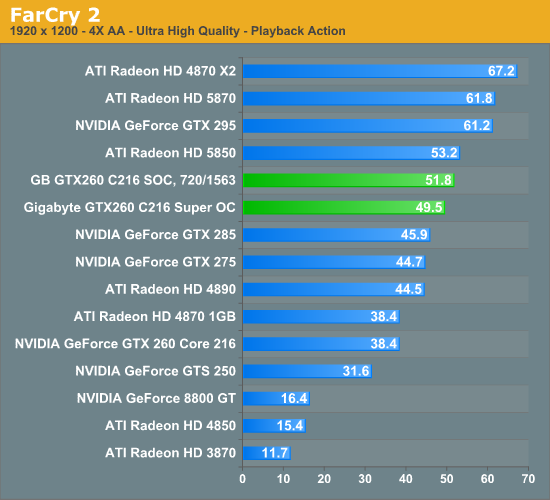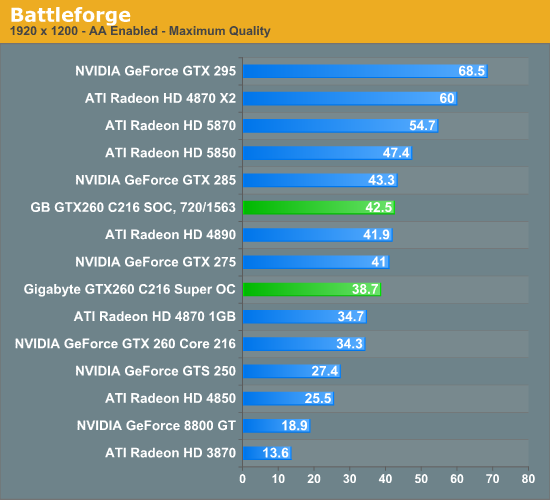Gigabyte's GTX 260 Super Overclock: A GTX 275 on the Cheap?
by Ryan Smith on October 11, 2009 12:00 AM EST- Posted in
- GPUs
Overclocking
Since the GTX260 Super Overclock is a card geared towards overclocking, we decided to push it a bit more and see what we can get. Gigabyte’s press materials claim that they pick a point below the limit of the card, in order to balance power consumption with performance. If that’s the case, we should be able to get a bit more out of it.
In this case, we got 720MHz/1563MHz/2600MHz out of the core, shaders, and memory respectively. This is a 5% core overclock, 4% shader overclock, and 4% memory overclock as compared to the default settings on the GTX260 Super Overclock, and a 25%/26%/30% overclock over the stock GTX 260 Core 216.



Ultimately while it’s true that there was some room left for overclocking, clearly Gigabyte has already squeezed out most of what they can. The performance boost offered by overclocking nets us a frame or two, but it doesn’t make nearly the different that Gigabyte’s initial overclock did. At best, it cements the GTX260 Super Overclock’s lead over a stock GTX275.
Free performance is free performance, but this card is clearly geared towards people that want the benefits of overclocking without the hassle or the warranty risk. If you’re looking for something specifically to overclock, this card isn’t going to be for you.










29 Comments
View All Comments
palladium - Monday, October 12, 2009 - link
Just wondering, with HAWX, is DX10.1 enabled for ATI cards?Ryan Smith - Monday, October 12, 2009 - link
No.Nfarce - Monday, October 12, 2009 - link
I just ask because I bought a stock EVGA 275 and have it overclocked quite nicely, which puts it above the performance of this o/c 260. Even AT posted about the 275's performance capabilities in an article back on June 4. You aren't really comparing apples to apples here other than one being purchased factory overclocked and others being purchased factory stock. No serious gamer ever keeps a video card stock just like a CPU.Ryan Smith - Monday, October 12, 2009 - link
Absolutely. User overclocking is by no means guaranteed, whereas factory overclocking is as good as anything else sold.As I stated in the article this card is a poor choice if you intend to do any overclocking on your own, but if you're the kind of person that does not do any overclocking (and I do know "serious gamers" that don't touch their card's clocks) then this is just as good as a GTX 275.
Abhilash - Monday, October 12, 2009 - link
It is not worth the 25% premium over a stock gtx260.Where is the power consumption results???
Ryan Smith - Monday, October 12, 2009 - link
My Kill A Watt decided to kill itself during some testing this weekend. There wasn't time to get it replaced and run new tests while still meeting all of the article deadlines this week. It'll be back soon™.SirKronan - Monday, October 12, 2009 - link
That's what I was wondering from the first page of the review: "Ok, so it performs like a 275, but how much power does it consume to do the same amount of work?" The title and conclusion indicate the performance is there for $10 to $20 less, but I kept looking on the review pages for the only thing I really wanted to know: "How do they differ on power?"I am typically one who praises Anand's articles, but I wouldn't have even published this without at least some kind of power figures. I understand that your Killawatt got "killed" (er... died, heh), but at least give us figures from a UPS that has a wattage meter built in. What was the difference in overall power consumption? That would at least give us an idea of how much extra power the 260 OC'd is going to use versus a 275. If you game enough, the power savings might even nearly negate the extra $10 you save over 2 or 3 years, depending on where you live.
Finally - Monday, October 12, 2009 - link
Thanks for pointing this out. I was about to ask that.I guess that is the card's weak spot that would stand in the way of a "recommendation"...
Under the rug, under the rug...
7Enigma - Monday, October 12, 2009 - link
Ryan did mention in the comments above that his Kill-A-Watt died during testing so that would explain why the info is not there.What should have been mentioned (I may have missed it) in the article was this explaination. No where did I find it, and like most of us my first thought was, OK but how much more power is this thing using, as that makes a big difference in my personal buying decisions (and why the 5850 is so darn likable across the board).
Stas - Sunday, October 11, 2009 - link
As noted, 4890 is $20 cheaper than this Gigabyte card. Performance almost equal. But don't forget that you can easily get extra 100-150Mhz on the 4890 GPU with stock cooling, and 100-200 on memory. Which would make it 5-10% faster. So now we have a card (HD4890) that's cheaper ($20) AND faster than Gigabyte GTX260 O/C. I think it's a no brainer. Of course, Gigabyte did a great job with this card (I love Gigabyte), but you can only compete so well, when the limitation is set by the chip's architecture. Out of all GTX260 cards, this one is probably the best. But it isn't the best value or performance when compared to HD4890.P.S. Even with both cards at stock, in games where GTX260 prevails, it only does so by 10% or so. Wherever the HD4890 comes atop, it beats the other by up to 30%.